
A home made jet engine
Page 2 Contents
Page 1 --> Introduction | The gas turbine | The turbocharger
Page 2 --> My engine | Turbocharger pics | The frame
Page 3 --> The oil system | The ignition system | Oil and ignition pics
Page 4 --> The combustor | Links
|
My engine As can be seen from the descriptions and diagrams the gas turbine engine and the turbocharger have a lot in common. The difference is how and where the compressed air and fuel are burnt to produce hot gas to turn the turbine. The gas turbine engine has a combustor. The turbocharger has the engine of the vehicle it is attached to. If we remove that engine and replace it with a combustor of our own design the turbocharger becomes a gas turbine - a jet engine! Once I became interested in building my own engine I naturally had to find myself a turbocharger. I didn't know anything about them or how much one would cost me. So I took to the local phone book and began calling places, starting with those geographically closest to me. The very first place I called was just down the road and they happened to have an old turbocharger they could sell. I asked the price and some details and said I'd get back to them. I could hardly buy the first one I found now could I? I called around more places and got more quotes and found that the first one I'd had was very reasonable. I called them back and arranged to go and see it. I must admit I was quite excited when I went to see it. I wasn't quite sure what it would even look like. I'd seen pictures
of turbochargers on the Internet before but I'd never actually seen one. I wasn't even exactly sure I'd be able to tell if it
was a good one. From what I'd learnt on other web pages I knew more or less what to look for:
And this is what I found. Back to page 2 contents |
Turbocharger pics
Click on each picture for a larger version and description.
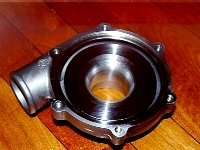
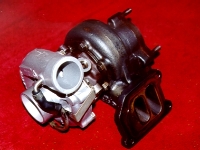
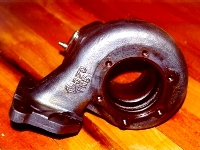
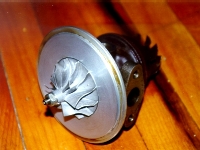
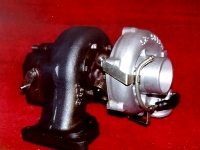
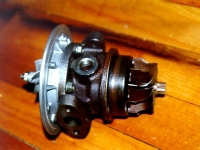
The turbocharger is a Hitachi HT18-2S taken off the engine from an Mazda RX-7.
Back to page 2 contents
|
The frame Once I had the turbocharger I needed a frame to build the engine around. I decided to make the frame using pieces of Dexion shelving. This consists of L-shaped pieces of steel with holes drilled along each face to allow it to be bolted together. I am using Dexion-160. I simply bought several lengths and cut it to the sizes I needed with a hacksaw. After painting the cut ends with rust inhibiting paint I bolted it all together with 8mm bolts. The numerous holes allow parts to be attached to the engine quickly and simply. And because it is all bolted together it is easy to make modifications as I go. To attach the turbocharger to the frame I made two flat aluminium plates which are bolted to the turbo using the same bolts that hold on the compressor and turbine volute housings. I used slightly longer bolts than the originals to allow for the thickness of the plates. The bottom of the plates are attached to two pieces of Dexion which are bolted on top of the frame. Before attaching the plates to the turbo I rotated the compressor and turbine volutes so that the compressor outlet and turbine inlet are parallel. I also made sure that the oil inlet and outlet were on the top and bottom of the engine respectively as it is mounted on the frame. I used a long spring between the waste gate lever and the frame to keep the waste gate held shut. Back to page 2 contentsOn to page 3 contents |
Copyright © 2000 - 2004 Simon Jansen